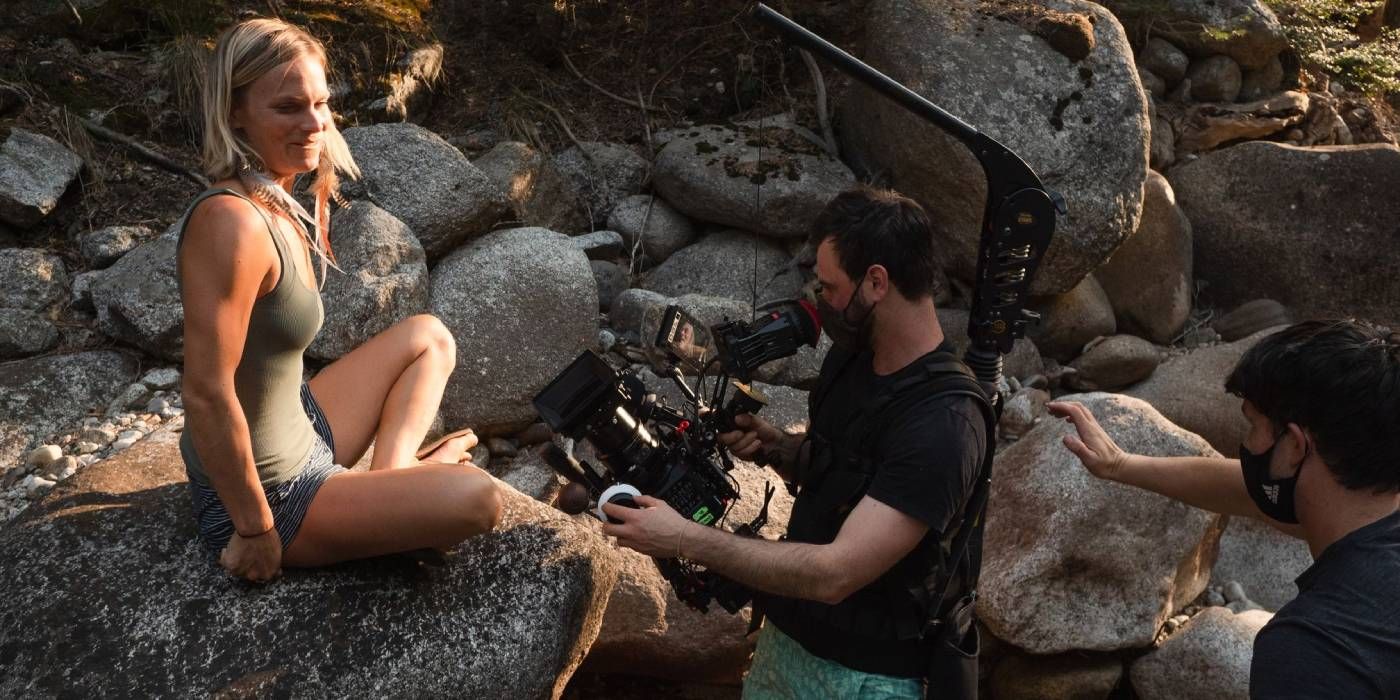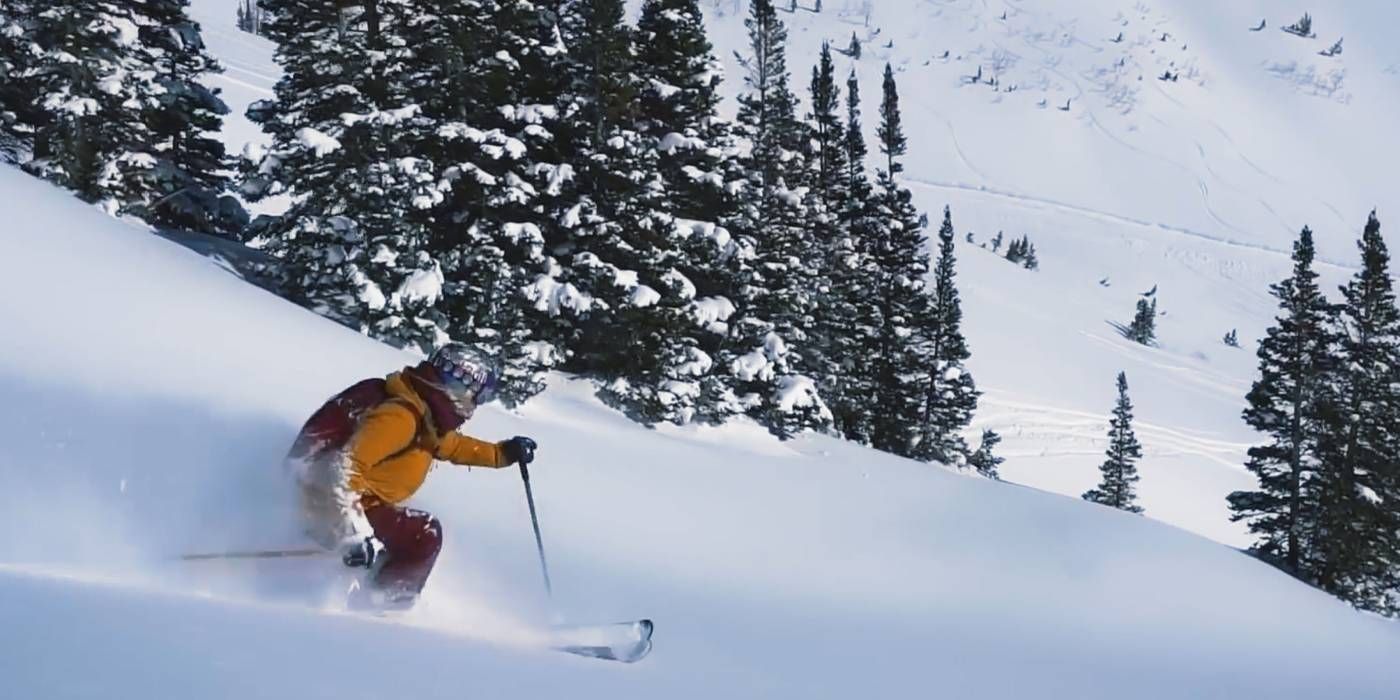Jimmy Chin's exploits as a mountain climber are some of the most amazing real-life adventure stories one can hear, but he's not the only outdoor athlete partaking in such incredible feats. The new National Geographic series Edge of the Unknown with Jimmy Chin shows viewers a very up-close look at the stories of Chin's fellow adventurers like Alex Honnold, Gerd Serrasolses, Conrad Anker, and many others with tales of free soloing, kayaking, and other sports in the world of Mother Nature. Famed skier Angel Collinson is also one of the subjects followed in Edge of the Unknown with Jimmy Chin.
Angel Collinson's accomplishments as a mountain skier are incredible, but her career took an unexpected turn when she took a 1,000-foot tumble down a mountain on one outing. Fortunately, she survived, but the event also marked a major turning point in Collison's life due to a knee injury sustained in her fall. Collinson would subsequently enter a new sport entirely in sailing, with Edge of the Unknown with Jimmy Chin following her story.
We speak to Angel Collinson about her skiing career, shifting from skiing to sailing after her fall, and how her story is told on Edge of the Unknown with Jimmy Chin.
Screen Rant: How did you become involved with Edge of the Unknown with Jimmy Chin?
Angel Collinson: I’ve known Jimmy for about ten years, and he knows me and my story, and they reached out, I think in January last year, and we filmed the interview a year ago.
With the theme of the show being people in daredevil kinds of outdoor activities and endeavors, and yours of course involved a very significant fall, what can you share about how that impacted your career and how you recovered from the fall?
Angel Collinson: Well, it is a high-risk sport. When things go wrong, it’s a whole spectrum of how bad things can go, but if they go really bad, they can go very badly. So, this show is about this fall that I took that was about 1,000 feet and ended up blowing out my knee. All in all, it could’ve been worse, I could have been much more hurt, but a knee injury takes a skier out for a while. It’s really two years before you’re back to where you need to be, so there’s many things that go along with these catalyzing moments that happen.
My backstory was that I was kind of ready to be done skiing already, and this helped me realize ‘I don’t want to be doing this anymore, and also, what else do I want to be doing with my life?’ So, the show is kind of about this moment about what goes along with it pushing the edge of the sport, and also for me, it was an opening for what’s next, and I’ve since changed my lifestyle completely and learned how to sail, and I’ve never been happier. So, it was both an ending and a beginning.
Did you ever have any other big injuries in your skiing career?
Angel Collinson: Yeah, I blew out my knew in a less violent fall a few years before that. Most skiers have that kind of injury happen to them at some point in their career.
With that all happening in Alaska, could you give some background on the location you were at and some of the risks that tend to come with skiing in that particular landscape?
Angel Collinson: Yeah, Alaska was kind of my bread and butter. You fly up to Alaska, and the mountains up there just go on forever, you can’t see the end of them. It’s insane, it looks like you’re looking on an ocean of waves, it’s just all huge, white-tipped mountains. On this particular trip, we flew to a small town, and then from the house we were staying at, we took a helicopter into the mountains, because you’re right at the base of the mountain. So, the daily commute is a helicopter and that’s a pretty amazing way to travel, and you get a pretty good lay of the land.
There are a lot of things that go into making the sport safe, because it has a lot of inherent risk, and you spend a lot of time learning how to manage it. People ask ‘What do you do about avalanches?’ and things like that, and there’s so much time and energy that goes into studying snow science and snow pack, as well as all of your own training, so you perform at your absolute best. The mountains up there are also very, very steep, and you can kind of see in this episode that even if you fall going slowly, you can’t stop, so you’ve got to nail it up there.
When Jimmy Chin approached you about featuring your story on the show, what were some of your main objectives you wanted to convey through your story in your episode?
Angel Collinson: Well, the episodes are these moments where we push the edge and experience maybe something that went wrong or what happens when you're at the edge. So, this series is very much about trying to whittle away how you deal with the risks of the sport, at least, in mine, it was a lot about that. What are the risks? How do you deal with them? How do you manage them? What happens when you don't manage them well? So, it was very much about understanding consequences, understanding yourself and how you deal with them and kind of getting in the minds of all of us and how we do it.
You've since gone into sailing. With the transition to that from skiing, was that something you had to learn a completely new skill set for, or did any of the preparations from skiing translate to that in any capacity?
Angel Collinson: It's a bit of both. I had to learn so much about the mechanics of sailing with our forty-foot boat that I did not know how to use at all. So, I had to learn that whole sport and how to basically read the wind. Where skiing has transferred over is I'm learning how to read the Earth and nature's language. When we're in these natural environments, you're reading the signs of the changing environment all the time, and if you're doing a good job, you can anticipate squalls coming, when the snow pack is getting unsafe and it might be starting to turn to avalanche conditions.
The skills that I've learned to pay attention to environmental signs and changes are transferring over to the ocean, and that's been really cool, and also just dealing with fear or scary moments or practicing safety skill sets, all of those were an unexpected transfer, which is cool.
Going back to skiing, for people who might just be starting out in that arena, what advice would you give to them as far as getting started on that journey?
Angel Collinson: Well, for anyone who is looking to go back country skiing, like out in the mountains outside of ski resorts, I would say the first thing you should do is take a back country education course, so that you learn the risks that you might not even know are out there and how to manage them and mitigate them. So, take a course, go with people who are more experienced than you, and something that I think would hold true if someone is going into the back country or if they just want to be a better skier and ski some steeper terrain in their resort, there's many different learning styles, so it's good to figure out what your learning style is and leaning into it.
For me, the way that I work with fear and doing hard, scary things is I never push myself way past my comfort zone. I really work in incremental steps and I gain my confidence by doing little bits at a time and not pushing myself too hard. That's when I see a lot of people get hurt is when they're trying to go a little bit too hard too fast, so have patience and know your learning style.
As far as your general skiing career, what was your favorite or biggest terrain you skied on without any kind of accidents such as the one in the show?
Angel Collinson: Well, up in Alaska, the mountains are just spectacular, and in 2014 or 2015, I won an award that no woman had ever won for Best Line, and was basically for the most impressive ski line that anyone had ever skied, so that was a huge honor. That was probably one of my favorite moments from skiing.
With your episode specifically, what was your favorite part of it and telling the story of your transition from one sport to another?
Angel Collinson: I think being asked to do it with these other really high caliber athletes was really cool. When I left skiing, I was not expecting to feel so much recognition, so it was just icing on the cake, and just the experience of filming with the production crew was really cool. I've worked with film companies a lot before because of working in ski movies, but it was kind of cool to have Nat Geo come in the house and just the way that they re-arranged the entire living room and seeing all of the latest and greatest technology and equipment was also very cool to be a part of.
How long had you skied before retiring, and what was the biggest challenge that you encountered, other than your accident?
Angel Collinson: I did it for 10 years, and after the accident, I still skied for another two. I didn't quit skiing cold turkey after the accident, but that was the point where I started kind of started diversifying my bonds and that was also when I boat my sailboat. I think one of the hardest things in my career, which sounds kind of funny, is I grew up racing and free skiing was always my passion.
I gave up a lot up for ski racing, but in my free time, I got to go ski around the mountains by myself, no rules, no coaches, and that was really fun. When I started doing it professionally, I think I probably encountered what a lot of people who do their hobby or their passion encounter is, which is once it becomes your job, how do you keep it fun, and how do you keep the passion alive and not burn out? And so, it was kind of an ongoing battle with that.
Now that you've jumped from skiing to sailing, what is the biggest thing you hope viewers take away from your story in Edge of the Unknown with Jimmy Chin?
Angel Collinson: Well, speaking from my experience and my episode, I really hope the takeaway is to be able to do something fully and then not be afraid to step away from it. For me, it was very much a beginning. I feel like my life is just starting, and I've never been happier, so I hope the takeaway is you can have these catalyzing agents for change and when we really use the challenge for growth, it's been the best ever, so I hope people see that in the story.
Edge of the Unknown with Jimmy Chin premieres on the National Geographic Channel on Monday, Sept. 5, at 9:30 PM EST, with all episodes on Disney+ on September 7.


